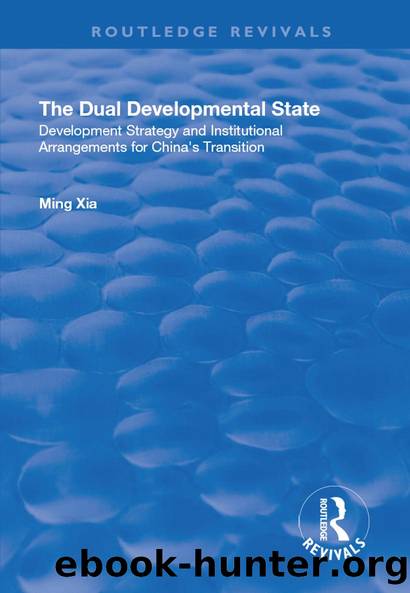The Dual Developmental State: Development Strategy and Institutional Arrangements for China's Transition by Ming Xia

Author:Ming Xia [Xia, Ming]
Language: eng
Format: epub
ISBN: 9781351781251
Goodreads: 36985157
Publisher: Routledge
Published: 2017-12-01T00:00:00+00:00
Constructive Strategy, Positive Results
This chapter moves beyond the frame of reference that views power relationships as either confrontation or domination, and views the power relationship between the NPC and other power players as a power grid, or network. This perspective has changed the nature of power relationships among the major players (the NPC, the CPC, and the government) from a relationship of dependency (or antagonistic tension when liberalization occurs) to one of interdependence. Power is defined as a combination of domination and influence. Without domination, a political actor still has room to accumulate power (Knoke 1990, 3-7). To explain why this has happened, I have examined the political environment and internal dynamics for the NPCâs development.
By reviewing the milestone studies on the NPC and the tenures of different chairmen, I have discussed various images of the NPC in its various stages of evolution. I have found, despite the disagreements among these studies, a common assumption links them together: They have applied the pluralist approach to evaluate the NPCâs power by focusing on competition and contestation. My study has traced the historical background to identify the salient factors for the NPCâs development. Deng Xiaopingâs guideline for Chinaâs reform course and his choice of the developmental state model cast a choice-set upon the Chinese legislative development, and set it on the track of a hybrid mode of governance, distinguishable from both the market and hierarchical modes of governance as a way for organizing politico-economic transactions. Defined by the parameters of the hybrid mode, the institutional design of the NPC has inherited legacies from the hierarchical mode of Stalinism and has also included some qualities associated with the market mode. As a result, the NPC is characterized by a hierarchical structure internally with loose linkages to local PCs and other political institutions. The loose linkages are characterized by a mixture of competition and cooperation, autonomy and interdependence.
The institutional design of the NPC and its political environment imposed tremendous constraints upon the behavior of the NPC in its interactions with other political institutions, especially the Party and the government. Subsequently, three waves of veteran leaders moving to the NPC brought political influence and connections to this institution. The hybrid mode (the network strategy) for Chinese development, a traditional political culture of âguanxi,â produced a phenomenon of âmoheâ in Chinese political life. It has presented a way of interpreting the political life of China.
My study shows why the NPC has played a unique role when compared to that generally played by legislatures in a political and economic transition. Parliaments in transitional societies easily become either a docile prey of the executive power or a bellicose challenger to it. In the former case, under a hierarchy of bureaucratic control, the hegemonic executive often hampers legislative development. Parliaments are often marginal and become either irrelevant to the economic transition or, at best, merely a junior helpmate for the executive or party-dominated state. In the latter case, under the competitive mode of pluralism, liberalized parliaments often intensify their confrontation and hostility to other power players.
Download
This site does not store any files on its server. We only index and link to content provided by other sites. Please contact the content providers to delete copyright contents if any and email us, we'll remove relevant links or contents immediately.
Cecilia; Or, Memoirs of an Heiress — Volume 1 by Fanny Burney(32437)
Cecilia; Or, Memoirs of an Heiress — Volume 2 by Fanny Burney(31873)
Cecilia; Or, Memoirs of an Heiress — Volume 3 by Fanny Burney(31857)
The Great Music City by Andrea Baker(31488)
We're Going to Need More Wine by Gabrielle Union(18972)
All the Missing Girls by Megan Miranda(15585)
Pimp by Iceberg Slim(14397)
Bombshells: Glamour Girls of a Lifetime by Sullivan Steve(13977)
Talking to Strangers by Malcolm Gladwell(13227)
Norse Mythology by Gaiman Neil(13211)
Fifty Shades Freed by E L James(13158)
For the Love of Europe by Rick Steves(13049)
Mindhunter: Inside the FBI's Elite Serial Crime Unit by John E. Douglas & Mark Olshaker(9206)
Crazy Rich Asians by Kevin Kwan(9170)
The Lost Art of Listening by Michael P. Nichols(7411)
Enlightenment Now: The Case for Reason, Science, Humanism, and Progress by Steven Pinker(7239)
The Four Agreements by Don Miguel Ruiz(6636)
Bad Blood by John Carreyrou(6555)
Weapons of Math Destruction by Cathy O'Neil(6148)
